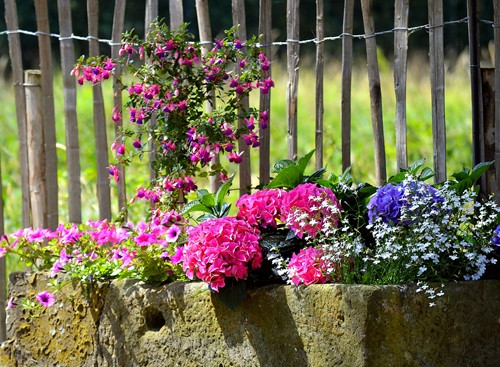
Container gardening can be an excellent way to grow and enjoy plants with limited space. It also allows you the opportunity to be creative and set up aesthetically pleasing combinations perfect for your garden or outdoor space. Here are some basic tips for a successful container garden:
Container
Container planting allows a lot of flexibility both in terms of plants and the actual container. Almost any material will work for container planting, whether it’s terra cotta, ceramic, wood or plastic. Choose a container that matches the look you’re going for, but make sure it has drainage holes in the bottom to allow excess moisture to filter out. The size of container you choose will depend on the amount of plants you are planning to include in it. However, it’s a good idea to go bigger than you think you need. It’s easier to fill in with an extra plant than to cram too many into a crowded space.
Potting Mix
Potting mix is another area with some flexibility. The key tip here is to avoid using the soil from your garden or yard and instead go with a quality commercial soil mix. This way, you’ll know exactly what’s in it and that your plants are getting the proper chemical balance for growth. Look for ingredients like perlite and vermiculite to help with drainage—especially important when planning succulents or other drought-resistant plants.
Light Compatibility
It’s crucial to read every plant tag (or research prior to shopping) to understand individual lighting needs. One of the most common mistakes in container gardening is trying to mix plants with incompatible light requirements. Direct sun-loving plants will not mix with shade-loving plants. If you’re going for an edible container garden, note that most vegetables require full sun and therefore shouldn’t be mixed with flowers or plants that prefer shade and cooler temperatures. Luckily, there are many resources both online and in print to help you plan compatible combinations of plants—just look up garden planning and you’ll find the guidance you need.
Water & Fertilize Regularly
When you plant in containers, you will need to water more frequently than if you were planting in the ground. Because container plants won’t be able to access the natural moisture levels in the soil, they dry out quicker. A solid guideline is to water whenever the soil in the container feels dry. Look up your specific plants, though. Succulents and cacti will stay happy longer without watering compared to other plants and may actually suffer from too much watering.
As for fertilizer, keeping a steady supply of macronutrients is a key to beautiful flowers all season. Liquid fertilizer is a convenient option because you can dilute it with water and add it during your normal watering routine.
Prune & Deadhead
Flowers don’t last forever, but by cutting off the old and faded blooms you can encourage fresh growth. This is called “dead-heading” and can often result in multiple flowers growing where there was only one. You can pinch away the spent blooms by hand or use pruning shears. For plants that might grow “leggy” and extend beyond the planter, don’t be afraid to trim their long branches and leaves as well. This will encourage the plant to produce new growth and sometimes can make them bushier and more dense.
These are just the basics of container gardening. You have a lot of room to experiment and get creative with your combinations. The more you research your plants’ specific needs, the more successful and healthy your container garden will be.